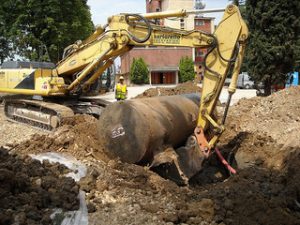 The process of underground storage tank removalcan be quite a bit more complex than you might think. Unfortunately, you can’t just bring in a backhoe and get to it, because you aren’t digging up just any tank. Between the regulatory requirements and the potential for problems relating to contamination, you have to be well-organized.
The process of underground storage tank removalcan be quite a bit more complex than you might think. Unfortunately, you can’t just bring in a backhoe and get to it, because you aren’t digging up just any tank. Between the regulatory requirements and the potential for problems relating to contamination, you have to be well-organized.
Some thoughtful advance planning will help ensure all goes smoothly and you’re prepared to handle any ugly surprises.
Know the procedures you’ll need to follow.
Make sure you have the right permits. You already know that underground storage tanks are governed by the US Environmental Protection Agency as well as the New York State Department of Environmental Conservation, through their Bulk Storage Program. Every state has a similar agency and program. But you may need local permits, too. And it’s always a good idea to locate any utility lines that may run near your proposed excavation area.
Once it’s uncovered, your tank has to be cleaned out and inspected to determine its condition. Are there records – or even informal stories – that indicate problems such as leaks have occurred in the past?
Even if your tank has been idle for some time, if you used it to contain petroleum fuels or other hazardous chemicals your plan for underground storage tank removal must include a scientific site investigation. The ramifications of contamination could be widespread and serious. So you’ll need to visually inspect the area around your tank and take soil samples. Testing will determine whether hazardous substances are present.
You can’t do this work yourself.
You need certified excavation technicians, because underground storage tank removal is potentially hazardous. There can be a risk of explosion or fire if procedures for uncovering the tank, clearing vapors, removing residue, etc. aren’t performed properly.
You also need a certified professional to conduct your sampling and testing.
Hiring an environmental engineering firm gives you a “one-stop” option to plan and implement your underground storage tank removal process so you can be sure nothing is missed. They’ll help you hire and supervise the right excavation contractor, perform required soil sampling and testing and draft the final closure report you must file with the authorities.
A single point of contact streamlines the entire process and ensures clear communication. It may even help save money. Instead of a several separate contractors you’ll get a single team of geologists and hydrogeologists whose expertise centers around working with hazardous chemicals.
Since they understand the big picture of storing and handling the kinds of chemicals you use, they can also help you develop an ongoing sampling and monitoring program that efficiently and cost-effectively complies with all regulatory requirements. And of course they can develop a remediation plan if you need one.
There are two possible results of underground storage tank removal.
If test results from your soil samples indicate there is no contamination, you’re free to finalize the removal process by refilling the hole and otherwise restoring the site.
However, if your samples show contamination is present, you’ll have to prepare a detailed clean-up plan.
While removal is a common method of decommissioning storage tanks, it’s also possible to abandon a tank in place, if it’s is in good shape and the surrounding area is found to be free of contamination. There are specific steps that need to be taken to complete the abandonment process, too, but in the end it can be considerably less expensive.
Advance planning will ensure your underground storage tank removal goes smoothly from start to finish, leaving you with a site you’re sure is clean or a plan you’re confident will clean it up.
Photo Credit: US Army Environmental Command
